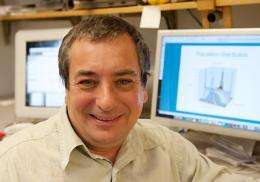'Nature' Paper Refigures the Evolution of Altruism

(PhysOrg.com) -- In 1871, Charles Darwin puzzled over the evolution of altruism. "He who was ready to sacrifice his life, as many a savage has been," he wrote in The Descent of Man, "rather than betray his comrades, would often leave no offspring to inherit his noble nature."
To this day, biologists debate about how altruistic behaviors evolve and persist. Sterile ants faithfully tend their queen with no chance of reproducing themselves. Vervet monkeys scream to other monkeys about approaching predators, drawing attention to themselves and risking their own safety. Bees lay down their lives to defend the hive.
"Why do they do that?" asks University of Vermont biologist Charles Goodnight. "Doesn't natural selection drive animals to behaviors that increase their own chances of survival, not those of others?"
This question underlies the decades-long debate -- sometimes rancorous -- between two camps of scientists. On one side, are those who argue in favor of "kin selection," in which individuals are altruistic to those who share their genes. In defending the hive, a self-sacrificing bee increases the chances that the genes she shares with her sisters will get passed down.
On the other side, are those who argue in favor of "group selection," (or, in its modern form, "multilevel selection") in which altruism arises from being part of a group. The self-sacrificing behavior of the bee persists and spreads across generations because the whole hive, a group, competes more successfully, leaving more offspring than others.
In the February 18 edition of the journal Nature a team of 18 scientists, including UVM's Goodnight, show that the two traditional approaches are actually mathematically equivalent.
One in the same
How can this be? In order for kin selection to be important, the related kin have to be in groups that preferentially confer altruistic behaviors on each other. In order for group selection to operate, the members of a group have to be closer kin than they are to other groups. The two ideas are close enough that they can actually be converted to each other mathematically. This understanding has been stated in technical research articles for more than 30 years, but the broader scientific community has not often recognized it.
"What we did in this paper was take the equations of a group that was very strongly kin selectionist and we worked through them and translated them back into classic equations," says Goodnight. "and they're the same."
"It is remarkable that kin selection has been widely accepted and group selection widely disparaged," says Michael Wade, a biologist at Indiana University, and the lead author on the paper, "when they are actually equivalent mathematically."
Evolution at all levels
A good bit of the fight between kin and group selection proponents is a product of history. (What fight isn't?) In the 1960's, some ideas about group selection were introduced that, in cartoon fashion, looked something like birds choosing not to reproduce for the good of their fellow birds. "There was this big rash of 'for the good of the group', naďve versions of evolution," says Goodnight.
But birds can't choose not to reproduce, nor can bacteria choose to be less virulent -- because it's good for their group. "Evolution doesn't work that way; evolution works by who leaves the most offspring," says Goodnight. Richard Dawkins and many other theorists largely dismantled this first wave of group selection ideas, and kin selection was ascendant. But in recent decades a new group-selection camp -- including Goodnight, David Sloan Wilson and others -- has emerged.
"The point is that evolution can work at many levels: the gene level, the cell level, the organismal level, the group level," Goodnight says, "and it probably works on all these levels at once."
The new paper in Nature considers the evolutionary mechanisms that would lead some parasites to have reduced virulence. From the kin selection (or individual-level selection) perspective, as presented in an earlier Nature paper by Geoff Wild at the University of Western Ontario and his colleagues, this lower virulence can be explained entirely by individual selection -- no group effect needed.
But Goodnight and his colleagues make a mathematical rebuttal, sketching out in their paper an argument for why two forms of opposing group selection -- "within-group" versus "among-group" -- are needed to explain how this seemingly disadvantageous trait nevertheless evolves in the whole parasite population.
"Those of us working on multilevel selection models have started seeing kin selection as subset of multilevel selection," Goodnight says, "The debate should no longer be whether it's individual or multilevel selection. The debate is how strong is each level of selection?" Or, as their paper concludes, "it's time to put the anachronistic debate between single-level and multilevel selection behind us."
Individual preference
Goodnight's colleague in the UVM biology department, Sara Cahan, agrees with this conclusion. But she doesn't agree with everything in Goodnight's paper -- and is more in the kin selection camp. "Charles and I really enjoy one another -- I respect Charles very highly -- but we do tend to argue a lot," she says, with a laugh. (Perhaps it's no wonder the students she and Goodnight had in their co-taught graduate seminar "Levels of Selection" called the course "Crossfire.")
"In this case of virulence, and in many cases where this altruism argument has been battled," she says, "the trait of interest is an individual-level trait. And if it's an individual-level trait, we really need to think about it as an individual-level adaptation -- regardless of what kind of selection, group or otherwise, has acted it."
"This debate is far from over," says Charles Goodnight.
More information: Paper: www.nature.com/nature/journal/ … abs/nature08809.html
Provided by University of Vermont














